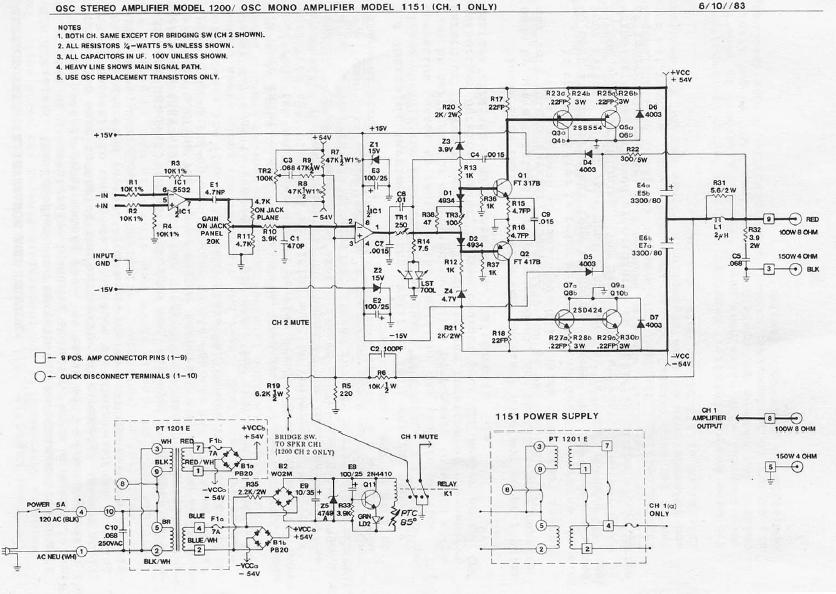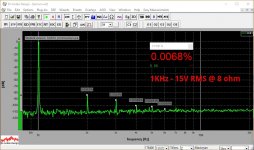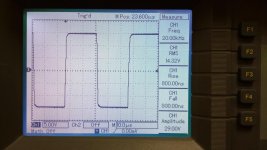> amplifiers with bandwidth of around 100kHz
The time difference, an amplifier with infinite response and an amplifier with 100KHz response, is like 0.02 inches of air-path, about the thickness of a matchbook cover.
Much less than the precision of alignment in multi-way speaker systems.
Much less than the usual head movement of a listener.
The "number of parts" in the amp has nothing to do with it.
The time difference, an amplifier with infinite response and an amplifier with 100KHz response, is like 0.02 inches of air-path, about the thickness of a matchbook cover.
Much less than the precision of alignment in multi-way speaker systems.
Much less than the usual head movement of a listener.
The "number of parts" in the amp has nothing to do with it.
I.e. Could the phase of one go past 360°? And be unable to catch up with the other.
The phase of the amp itself (no other filter mumbo jumbo) within the audio bandwidth, will be approximately the same regardless of design. If this was not the case, they would be oscillators not amplifiers. Phase shift of 180 degrees is positive feedback. The only situation that will cause concern, is if one amp has an inverted output. This is a 180 phase inversion by design like a Quad 303. This is not phase shift. In this case the DSP processes can invert for that amp.
For greater insight learn LTSpice and start with a simple opamp design. Substitution of parts from simple to complex will demonstrate the principle.
Off topic but...
Lower NFB could be helping designs conform better with optimal servo behavior. A number of designs on this forum over-cook it in the drive for low distortion. Good behavior is easier to achieve with lower parts count. JLH came from an industrial background and understood that.
Lower NFB could be helping designs conform better with optimal servo behavior. A number of designs on this forum over-cook it in the drive for low distortion. Good behavior is easier to achieve with lower parts count. JLH came from an industrial background and understood that.
Off Topic; perhaps one or other of the members that have contributed to this thread and expressed an interest about how different topologies may contribute to imaging would like to start a thread about it? Three of them, to my knowledge, are successful commercial amplifier designers, so their thoughts, knowledge and experience may be of value to the rest of us as well as each other.
Off topic: I am curious about this topology that can give output voltage swings higher than usual Op-amp power supply rails.
Op-amp front end with an unusual OPS that needs floating PSU.

Is this a worthwhile topology for high quality sound ?
Op-amp front end with an unusual OPS that needs floating PSU.
Is this a worthwhile topology for high quality sound ?
Last edited:
As a stereo pair of signals cannot contain vertical information any appearance of 'vertical resolution' is simply the brain of the listener inventing something which is not present. It is just about conceivable that a less than perfect amp is adding something to the signal which the brain wrongly perceives as vertical information, while a better amp does not add so much of this distortion.
I'm inclined to agree, unfortunately this view has probably put an end to the discussion about what may really be going on.....
As a stereo pair of signals cannot contain vertical information any appearance of 'vertical resolution' is simply the brain of the listener inventing something which is not present. It is just about conceivable that a less than perfect amp is adding something to the signal which the brain wrongly perceives as vertical information, while a better amp does not add so much of this distortion.
I would think so, but it seems to be not that easy. Vertical resolution may be a result of some acoustic reflections, etc. - my listening space is relatively compact and has got no absorption material on the sides (only the back wall is non-reflective). Let's forget about the vertical resolution for now. The point is that low-global-feedback / no-global-feedback amplifiers provide higher phase resolution than the high-global-feedback ones. That may not be the case (just a perception), however, that's what we notice at the listening tests so far.
Simpelstark provides two key features: 1) incredibly natural sounding acoustic instruments and voices; 2) high resolution in terms of separation of the sound sources. Best big-band playing amplifier I've ever heard.
I don't mention the overall high level of detail, neutral tonal balance, very low noise - those are prerequisites.
I have no idea about "why" right now. Just an observation.
The point is that low-global-feedback / no-global-feedback amplifiers provide higher phase resolution than the high-global-feedback ones. That may not be the case (just a perception), however, that's what we notice at the listening tests so far.
I have the same observation which is why I am working on a SE Class A amp that puts our 50w at 0.002% THD with no global feedback.
What you are describing reads to me to be low level of dynamic intermodulations (including excess noise causing phase modulations) causing maskings...Simpelstark provides two key features:
1) incredibly natural sounding acoustic instruments and voices;
2) high resolution in terms of separation of the sound sources.
Best big-band playing amplifier I've ever heard.
I don't mention the overall high level of detail, neutral tonal balance, very low noise - those are prerequisites.
I have no idea about "why" right now. Just an observation.
In my experimentations with filtering noise sources this masking peels away and your (and mine) prerequisites just emerge as should be expected.
High loop feedback causes 'nervousness' and masking due to triggering and excitation of excess noise mechanisms causing 'erratic' noise that 'rides' with the signal.
These excess noise mechanisms can also be resonant giving rise to emphasis or signature.
Stationary noise (white/pink etc) is relatively/readily ignored as are harmonic distortions, however imd and dynamic noise modulations are readily detected and imply dynamic change in dynamic transfer function.
As survival mechanism sensitivity to these audible dynamic changes would point to some kind of change in local environment, stationary noises/sounds inform of 'status quo' in the local environment.
Dan.
Last edited:
..curious about this topology...
The electrons do not see topology. The current gain distribution is not unusual and not flawed. (This is one of the smaller QSCs; they got fancier.)
The down-side is that these are a real mind-bend to troubleshoot, since all your hard-won experience is now backward. I know I could leap that hurtle if I fixed these all day long.
The collectors are grounded. This tempts you to bolt them solid to sink to chassis, no insulator. If you do that, you better not use the chassis for input returns.
We have good VAS transistors today, which makes it simpler to use D.Self "Blameless" topology and Cordell's teachings than to build the output stage inside out.
Yes, it is just a perception. A low feedback amp is likely to have a less flat phase and frequency response than a high feedback amp. It may be that this lack of flatness affects the signal in a similar way to the external ear, and so the brain wrongly concludes that there is vertical information present.vzaichenko said:The point is that low-global-feedback / no-global-feedback amplifiers provide higher phase resolution than the high-global-feedback ones. That may not be the case (just a perception), however, that's what we notice at the listening tests so far.
A low feedback amp is likely to have a less flat phase and frequency response than a high feedback amp. It may be that this lack of flatness affects the signal in a similar way to the external ear, and so the brain wrongly concludes that there is vertical information present.
Where does this come from? Sims of certain zero global feedback amps show just the opposite.
Take almost any amplifier. Add some feedback. The result is flatter frequency response in and near the passband. That is what feedback does. You appear to be claiming the opposite.
Of course, it is always possible to add too much feedback and get too close to instability but that is not evidence that feedback is bad; it is evidence that poor design is bad.
Of course, it is always possible to add too much feedback and get too close to instability but that is not evidence that feedback is bad; it is evidence that poor design is bad.
That's likely. Which could suggest a wider dispersion, could an amplifier's distortion or lack of, effect a speaker's dispersion?Vertical resolution may be a result of some acoustic reflections, etc.
DF96,
You seem to imply that an amp with lower levels of feedback that seems to have excellent vertical separation must have this as a result of non-flat phase playing tricks with the ear. I think that this presupposes something that is not necessarily true. A low feedback or zero global feedback amp can be flat phase. I have an LTSpice sim that shows <2deg phase variation from 100Hz to 300kHz (the important ranges) for a zero global feedback amp. It has outstanding imaging and depth of soundstage.
You seem to imply that an amp with lower levels of feedback that seems to have excellent vertical separation must have this as a result of non-flat phase playing tricks with the ear. I think that this presupposes something that is not necessarily true. A low feedback or zero global feedback amp can be flat phase. I have an LTSpice sim that shows <2deg phase variation from 100Hz to 300kHz (the important ranges) for a zero global feedback amp. It has outstanding imaging and depth of soundstage.
The question though remains where is this illusion of vertical separation coming from in the first place? How is it encoded in the recording and how can an amplifier effect it?DF96,
You seem to imply that an amp with lower levels of feedback that seems to have excellent vertical separation must have this as a result of non-flat phase playing tricks with the ear.
Yes, it is just a perception. A low feedback amp is likely to have a less flat phase and frequency response than a high feedback amp. It may be that this lack of flatness affects the signal in a similar way to the external ear, and so the brain wrongly concludes that there is vertical information present.
This is not the case. Simpelstark is an amplifier particularly designed for being used with low global feedback / no global feedback. It's got 300KHz bandwidth, pretty flat phase response (-2.8 degrees at 20KHz), and rather low THD / IMD with just 18db ODNF.
Forget about vertical effects - that's a separate story. The point is that overall resolution is very high. It sounds extremely good. Giving me inspiration for moving further in the direction of low global feedback amplifiers.
Attachments
Ok, I'm confused, you mentioned vertical positioning a number of times connected with low feedback amplifiers, now it's a separate issue?
Ok, I'm confused, you mentioned vertical positioning a number of times connected with low feedback amplifiers, now it's a separate issue?
This is not the main point here. My thinking on this is that high amount of information allows some reflections from the objects at different heights because of non-ideal conditions in my listening room. No problem.
What is more important - that's what's been noticed by me, Hugh, XRK - a perception of higher overall resolution (higher separation of sound sources) when listening to the amplifier with lower amount of global feedback, than when listening to the amplifier with higher amount of global feedback with comparable (or somewhat higher) characteristics, assuming all the other conditions are the same (e.g. signal source, speakers, listening room).
- Home
- Amplifiers
- Solid State
- Question regarding phase differences of amps.

